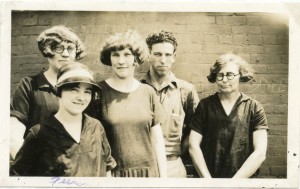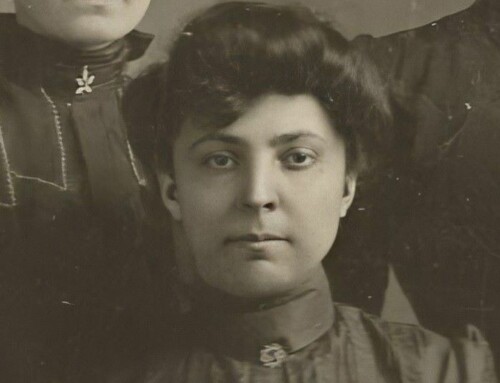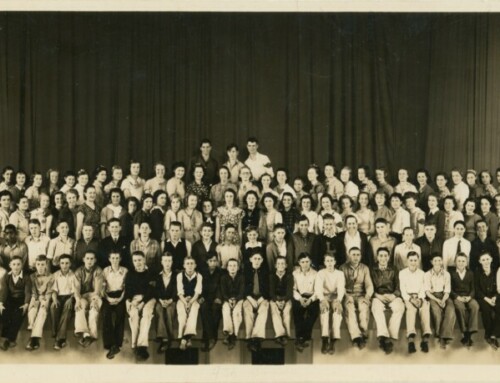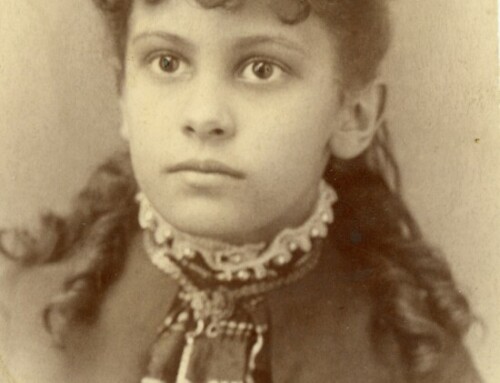
Dora (center) with fellow TKWM workers Fern Harper, Christina Heman, Chester Page, and Mrs. Grable in the late 1920s. Willamette Heritage Center M3-1992-117-0006
A simple tongue twister hooked them. Fifteen seconds of Dora Lehman Barnes, female millworker from 1925-1946 describing the jobs she held at the Thomas Kay Woolen Mill. In a sweet melodic voice we heard, “I’m a weaver, winder, twister, spooler, hanger, a drawer, and a dresser,” and I had five sets of teenage eyes riveted on me. Our first teen interpreter training for 2017 was off to a good start thanks to an oral history project interviewing surviving Thomas Kay Woolen Mill workers back in 1977.
Dora was born October 5, 1909 in Salem, Oregon to August and Anna Lehman, the youngest child of seven. Her father and his brother immigrated from Germany in 1891. They found work at the original Thomas Kay Woolen Mill that opened in 1889, and despite the devastating fire that burned the mill to the ground, August stayed, helping with the clean-up and re-building efforts. He was a master weaver and would go on to teach and train his sons and daughters, with one exception, in the wool mill industry.
Dora started work at the woolen mill a month shy of her 16th birthday when her oldest brother Carl brought her in and taught her to be a spooler. She was quick and smart and as a result, given more responsibility and trained in additional jobs. That same year she met her future husband Ora Barnes at the mill. Orey as he preferred to be called, was seven years older than Dora and had been married before. They waited until Christmas Eve 1927 to be married, after Dora’s 18th birthday and out of respect for her parent’s wishes.
After listening to an additional clip from the oral history interview we learned that Dora was very proud to have saved up $1500 during those years she waited to be married. Enough to buy their first home at 1160 S. 14th St. After their marriage Orey left the woolen mill to learn the butcher’s trade while Dora continued at the mill. They made it through the Depression years because they paid cash for their house and car, both had jobs though hours and pay had been cut, and the extended family shared a big garden.
Dora’s brother Otto was also interviewed as part of the same oral history project. From his tape we learned that Dora was an enthusiastic baseball fan, particularly when her husband stood behind home plate. Orey O. as he went by on the ballfield, short for Ora O’Farrell Barnes, was an amateur catcher in high demand. He played on the Thomas Kay Woolen Mill team and other teams when asked. Dora was his loudest fan according to her brother. He complained that you could hear her yelling from the ballfield two blocks away.
In 1946 Dora left the woolen mill to join her husband in a grocery store venture, opening Broadway Market at 1190 Broadway St. where Barrel and Keg is now. She became the assistant manager and checker until her husband’s retirement in 1964. Ora passed away in 1972 and Dora in 1989, both are buried in Belcrest Memorial Park.
As our teen interpreters often learn, researching a female ancestor or historic character prior to the mid-19th century can prove challenging between name changes thru marriage and laws that favored men and provided less opportunities for a spouse or daughter’s name to be recorded in legal documents such as tax and property records. That is why having an oral history tape, particularly of a female worker is so valuable. In Dora’s own words we learned what it was like to be a female worker in a predominantly male profession, the family connections at the mill that helped train and advance a person through more highly skilled jobs, and the primitive conditions they worked under such as outhouses and a water bucket with a communal cup instead of a drinking fountain. Some would say trivial details from a blue-collar life. But such details make for rich characters to interpret.
As we continued our teen interpreter training that day examining photographs of Dora and her family members, an apron and small purse with tools owned by another female millworker the teens begged to listen to more of Dora’s story. They connected with Dora. Her first job, saving for a major purchase, and romance at sixteen with an older guy. These connections ground the Willamette Heritage Center teen interpreters with a sense of their place in history. As they portray even the humblest of historic people they find ways to connect with their own lives and struggles, gain strength to make their voices heard and to forge their own path to the future, creating their own history.
This article was written by Kaylyn F. Mabey for the Statesman Journal where it was printed 19 February 19 2017. It is reproduced here with sources for reference purposes.
References:
- Oral History Interview – Dora Lehman Barnes – M3 1994-016-0026
- Oral History Interview – Otto Lehman – M3 1994-016-0004
- 1910-1940 US Federal Census Records
- Social Security Death Index
- Oregon Death Index
- 1930-1978 City Directories
- Find-a-Grave Memorial Website
- Obituary for Dora Barnes – Statesman Journal (Salem, OR) – December 29, 1989, p. 9
- Obituary for Ora Barnes – Statesman Journal (Salem, OR) – April 10, 1973, p. 8
- Birth Announcement for Dora Lehman – Statesman Journal (Salem, OR) – October 6, 1909, p. 5
- “Sips for Supper” Daily Capital Journal (Salem, OR) – February 23, 1945, p. 4
- “Ora Barnes, meat market operator in the new Safeway store” Daily Capital Journal (Salem, OR) – August 6, 1937, p. 3






